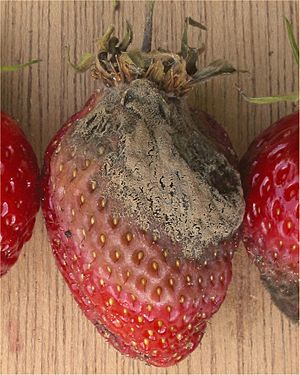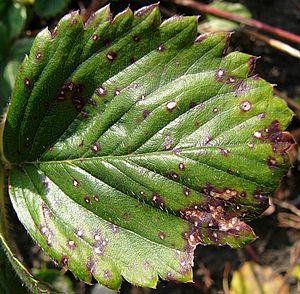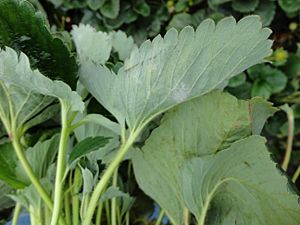List of strawberry diseases facts for kids
Strawberries are delicious fruits, but like all plants, they can get sick! These sicknesses are often caused by tiny living things like bacteria, fungi, or even tiny worms called nematodes. When strawberries get sick, it can affect their leaves, stems, roots, or even the fruit itself. Understanding these diseases helps farmers and gardeners keep strawberry plants healthy so we can enjoy more tasty berries!
Contents
Bacterial Diseases of Strawberries
Bacterial diseases are caused by very small living things called bacteria. They can make strawberry plants unhealthy in different ways.
Angular Leaf Spot
One common bacterial disease is called Angular leaf spot. It's caused by a bacterium named Xanthomonas fragariae. This disease makes small, dark, watery spots appear on the underside of strawberry leaves. These spots often look like tiny, dark green, angular shapes. As the disease gets worse, the spots can grow and turn reddish-brown, and the leaves might look shiny or greasy.
Other Bacterial Issues
Sometimes, bacteria can cause problems like Bacterial wilt, which makes the plant wilt and droop, or Cauliflower disease, which can make parts of the plant grow in strange, lumpy shapes, almost like a cauliflower.
Oomycete Diseases of Strawberries
Oomycetes are not true fungi, but they are often grouped with them because they cause similar plant diseases. They are sometimes called "water molds."
Downy Mildew
Downy mildew is an oomycete disease that affects strawberry leaves. It's caused by Peronospora potentillae. This disease creates pale green or yellow spots on the upper side of the leaves. If you look underneath, you might see a fuzzy, white or gray growth, especially when it's damp. This fuzzy growth is what gives the disease its "downy" name.
Fungal Diseases of Strawberries
Fungi are a big group of living things that include mushrooms, yeasts, and molds. Many plant diseases are caused by fungi. They can cause spots, rot, and wilting in strawberry plants.

Leaf Spots and Blights
Many fungi cause different kinds of spots and blights on strawberry leaves:
- Common leaf spot is caused by Mycosphaerella fragariae. It makes small, round, purple spots on the leaves. As the spots get older, their centers turn tan or gray.
- Leaf scorch is another fungal disease caused by Diplocarpon earlianum. It creates small, dark purple spots that spread quickly and can make the leaves look like they've been scorched or burned.
- Black leaf spot and Purple leaf spot are similar diseases that also cause dark spots on the leaves, making them look unhealthy.
Fruit Rots
Fungi are a major cause of fruit rot, which can ruin strawberry harvests.
- Anthracnose fruit rot is a serious disease caused by several fungi like Colletotrichum acutatum and Colletotrichum fragariae. It causes dark, sunken spots on the fruit, which can quickly spread and make the entire berry rot.
- Gray mold is very common and is caused by Botrytis cinerea. It makes soft, brown spots on the fruit, which then get covered in a fuzzy, gray mold. This can spread quickly from one berry to another, especially after harvest.
- Leather rot is caused by Phytophthora cactorum. Infected berries become tough and leathery, turning brown or purple. They often have a bitter taste.
- Rhizopus rot, also known as "leak," is caused by Rhizopus stolonifer. This rot makes the fruit very soft and watery, causing it to "leak" juice. It often has a fuzzy, black mold growing on it.
Root and Crown Rots
Some fungal diseases attack the roots and crown (the base of the plant where the leaves and roots meet) of the strawberry plant.
- Black root rot is a complex disease caused by several fungi, including Rhizoctonia fragariae and Pythium species. It damages the roots, making them dark and unhealthy, which prevents the plant from absorbing water and nutrients properly. This can make the plant stunted and weak.
- Phytophthora crown and root rot is caused by different Phytophthora species, like Phytophthora cactorum. It attacks the crown and roots, making them rot and turn reddish-brown. This can cause the entire plant to wilt and die suddenly.
- Red stele is a serious root disease caused by Phytophthora fragariae. It makes the center of the main root (the stele) turn a reddish-brown color. Infected plants become stunted, their leaves turn blue-green, and they often die.
- Verticillium wilt is caused by Verticillium albo-atrum or Verticillium dahliae. This fungus blocks the water-carrying tubes inside the plant, causing the outer leaves to wilt and turn brown, eventually leading to the plant's death.
Powdery Mildew
Powdery mildew is a common fungal disease caused by Podosphaera macularis. It creates a white, powdery coating on the leaves, especially on the underside. The leaves might curl upwards, and in severe cases, the fruit can also be affected, becoming stunted or distorted.
Miscellaneous Diseases and Disorders
Some problems affecting strawberries aren't caused by specific germs but by other issues.
- Pith necrosis and crown death and Rapid death are problems where the inside of the plant's crown dies, or the plant dies very quickly, but the exact cause isn't always known.
- Slime molds like Diachea leucopodia can sometimes grow on strawberry plants, looking like a slimy or powdery coating. They usually don't harm the plant much but can look strange.
Nematodes, Parasitic
Nematodes are tiny, often microscopic, roundworms that live in the soil. Some of them are parasitic, meaning they feed on plants and can cause damage.
Root-Feeding Nematodes
- Root-knot nematodes (like Meloidogyne hapla) are very common. They cause galls or "knots" to form on the roots, which makes it hard for the plant to take up water and nutrients. This can lead to stunted growth and wilting.
- Lesion nematodes (like Pratylenchus penetrans) create small, dark spots or "lesions" on the roots, damaging them and making the plant weak.
- Dagger nematodes (Xiphenema spp.) and Sting nematodes (Belonolaimus longicaudatus) are larger nematodes that feed on root tips, causing stunted root growth and overall plant weakness.
Foliar and Stem Nematodes
- Spring dwarf or foliar nematodes (Aphelenchoides fragariae) and Summer dwarf (Aphelenchoides besseyi) attack the buds and leaves. They can cause the leaves to become crinkled, distorted, or stunted, and the plant might not produce many runners or fruit.
Phytoplasma, Virus and Virus-like Diseases
Viruses are extremely tiny particles that can infect plants and cause diseases. Phytoplasmas are also very small, bacteria-like organisms that live inside plants. These diseases often spread through insects or by grafting.
Aphid-Transmitted Viruses
Aphids are small insects that feed on plant sap. As they feed, they can pick up viruses from one plant and spread them to another.
- Strawberry crinkle virus (SCV) causes leaves to become crinkled, distorted, and have yellow spots.
- Strawberry mild yellow-edge virus (SMYEV) makes the edges of the leaves turn yellow, especially in cooler weather.
- Strawberry mottle virus (SMV) can cause light green or yellow spots and a general mottling (uneven coloring) of the leaves.
- Strawberry vein banding virus (SVBV) causes clear or yellow bands along the veins of the leaves.
Leafhopper-Transmitted Phytoplasmas
Leafhoppers are another type of insect that can spread diseases.
- Aster yellows and Strawberry green petal are caused by phytoplasmas. These diseases can cause strawberry flowers to turn green and leafy instead of forming fruit, or make the plant grow in a strange, bushy way, like a "witches'-broom."
Nematode-Transmitted Viruses
Some viruses can be spread by the tiny parasitic nematodes in the soil.
- Viruses like Arabis mosaic virus and Tomato ringspot virus can cause stunted growth, yellowing, and general decline in strawberry plants.
Other Virus-like Conditions
- Strawberry pallidosis is a condition that can be spread by grafting or pollen. It can cause a pale color in the leaves and reduced plant vigor.
- Strawberry June yellows is a genetic problem, not caused by a germ. It makes the leaves turn yellow, especially in spring, and can weaken the plant over time.



